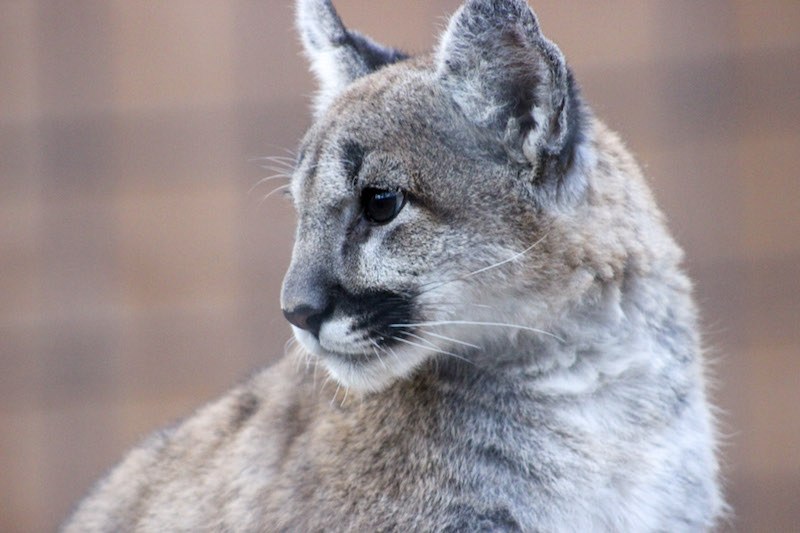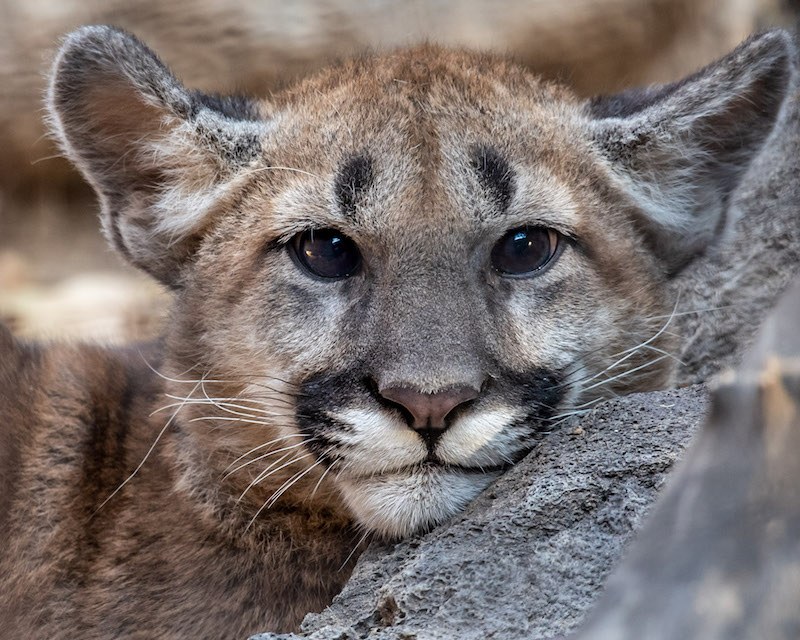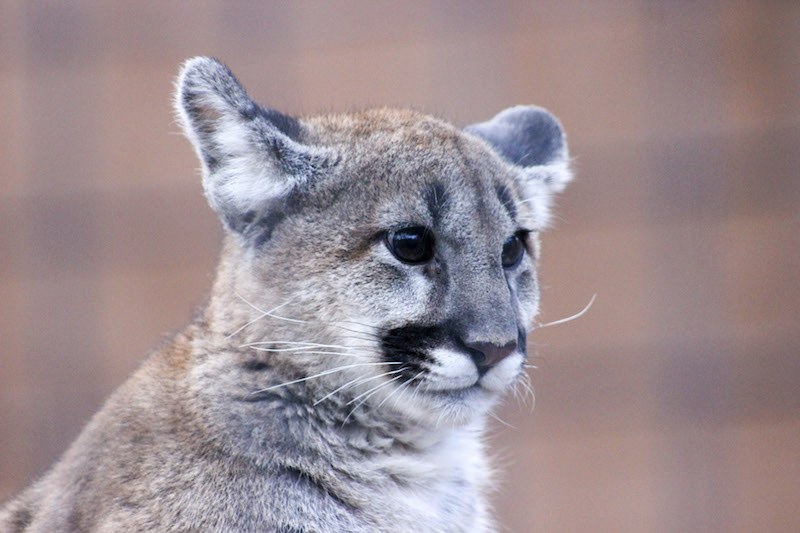Mountain Lions
Learn about mountain lions and move like one with an hands-on activity!
Learning Goal
Let’s pounce into today’s lesson plan! Discover the natural history of a mountain lion, learn about the ABQ BioPark’s animal ambassadors, and jump and bound like a mountain lion with our activity.
Introduction to Mountain Lions

Did you know that mountain lions, pumas, cougars and panthers are different names for the same animal? Because of their wide distribution—from Canada to Argentina—humans have described them over time with more than 40 names! These solitary felines range more extensively than any other mammal in the Western Hemisphere.
Early Spanish explorers in North and South America called these felines “león,” which translate to lion, and “gato monte,” meaning mountain cat (and that’s how we got the English name "mountain lion”). In the Inca language they gave this cat the name “puma.” “Cougar” comes from an old South American Indian word, “cuguacuarana,” which was then shortened to cuguar and spelled differently. While “panther” is a general term for cats that have solid-colored coats, it has been used to categorize both pumas as well as black jaguars. All of these names are considered correct, but scientists usually use the name puma, hence their scientific name, puma concolor. Here in the Southwestern region of the United States, they are commonly called mountain lions. Regardless of what you call it, it’s still the same cat and is the largest of the small wild cat species.
Thought to be one of the most adaptable cats of the Americas. Mountain lions inhabit a wide range of ecosystems, claiming anywhere where they can find shelter, an abundant amount of prey, water and enough space. Ranges include a variety of habitats such as forests, prairies, deserts and swamps. These cats live in home ranges that vary in size from 30 to 125 square miles. Because it has such a large territory, it may take a mountain lion a week to travel all the way through its home range. A mountain lion’s keen senses, muscular agility and ability to adapt to nearly any landscape makes this feline a successful hunter.
Like all cats, mountain lions are usually strict carnivores but make slight exceptions when prey is scarce. Their diet may consist of deer, elk, moose and bighorn sheep, though they also eat smaller animals such as coyotes, raccoons, rabbits, squirrels, mice and rats. Mountain lions are typically ambush predators, stalking their prey from behind and leaping on its back to deliver a suffocating neck blow. Mountain lions can bound up to 40 feet while running, leap 15 feet up into a tree, and climb well over 12 feet. Being so agile and nimble allows pumas to have a successful hunting technique.
Unlike lions, who live in a group or “pride,” mountain lions are very shy, elusive and solitary animals. They are mostly active during dawn and dusk; they take immense caution to avoid people and heavy populated areas with human activities. While mountain lions are solitary cats, they do break this exception during breeding and when mothers are rearing cubs. Mountain lions can breed year-round, and female mountain lions usually give birth about every two years. Litter size can range from one to six cubs and cubs may stay with their mother for as long as two years before venturing out on their own. They usually separate after only 15 months though.
How the ABQ BioPark Works With Mountain Lions
The ABQ BioPark is home to two mountain lions. A male club, Larabee, arrived at the BioPark in fall 2019. Larabee was discovered in somebody's backyard in Nebraska. The cub was originally found with its sibling, who later ran away; a deceased female mountain lion was later found and believed to be the cubs’ mother. The homeowner was able to care for the remaining cub, which was dehydrated and weak, until Nebraska Game and Parks could rescue him.
Larabee, whose name comes from the street where his rescuer lived, was taken to the Omaha’s Henry Doorly Zoo and Aquarium, where they temporarily cared for him for two more weeks before transferring him to Albuquerque. Larabee is not the ABQ BioPark’s first rescue mountain lion cub.The ABQ BioPark Zoo has collaborated with a number of organizations over the years including Nebraska Game and Parks and New Mexico Department of Game and Fish to offer refuge to rescued mountain lions.

The ABQ BioPark is also home to a female adult mountain lion named Gillin. Gillin arrived from the Northeastern Wisconsin Zoo and Adventure Park in fall 2019 and was once a rescue cub herself in Oregon. All mountain lions in Association of Zoos and Aquariums (AZA)-accredited facilities are rescues from the wild and the AZA does not have a breeding plan for species. This is because there are so many mountain lions in need of rescue due to hunting other human encroachment in mountain lion territory
Our Actions Matter

Although it once ranged freely throughout most of North and South America, by the beginning of the 20th century the mountain lion had been extirpated (local extinction) by human activities from nearly every state east of the Rockies, and was on the brink of extinction across the entire United States. This species was so wide-reaching and populous that it had multiple subspecies that varied based on geographic location. This subspecies phenomenon is created when biological populations of the same species become localized due to geographical isolation.
Throughout the 1800s and early 1900s, people feared the mountain lion because it posed a risk to their livestock. Although mountain lions are not prone to hunting cattle, they will do so when cattle move into their territory and their natural prey has diminished. The species was hunted and almost eradicated from the eastern United States. Due to recent conservation efforts, mountain lion populations in the western United States are stable, although far lower than they were historically. There are still an estimated 30,000 mountain lions in the western region of the United States. While there are still several thousand mountain lions in the wild, their population has significantly decreased from their historical numbers due to unsustainable hunting, habitat destruction and conflicts with agriculture livestock.
Mountain lions are an "umbrella species," meaning they require an ample amount of space for their conservation, which depends on the preservation of large amounts of land. A mountain lion usually requires about 13 times as much habitat as a black bear or 40 times as much area as a bobcat to thrive. By preserving enough wilderness to support a stable mountain lion population, we are also saving countless other species of native plants and animals that share mountain lion habitat.
Not all pumas have been able to recover. The eastern cougar, a subspecies of mountain lion, was declared officially extinct by the United States Fish and Wildlife Service in 2011, although individuals from western populations have been confirmed to wander as far as the East Coast. The Florida panther, the other United States subspecies of mountain lion, was listed as critically endangered in 1973. Today there are fewer than 160 Florida panthers left in the wild. They’re found only in secured and preserved areas such as Everglades National Park and Big Cypress National Preserve in southern Florida. The subspecies is threatened by habitat fragmentation, intraspecies aggression (flighting between panthers over limited territory), less available prey and disease. Florida panthers are so critically endangered that the population now faces challenges over genetic diversity and viability for future generations.
For the Los Angeles area, Urban Wildlife crossing is being proposed to restore habitat fragmentation for mountain lions.
Activity: Jump Like a Cat
Activity Description
Mountain lions are capable of climbing fantastic heights and taking great leaps. Grab a running start and jump as far as you can to reach incredible length like these felines!
Materials
- Chalk
- Ruler/measuring tape
Directions
- Measure out 40 feet on a sidewalk.
- Draw a line with chalk and place a start marker and a finish line.
- Now jump!
- How many leaps does it take you to reach 40 feet?
- Explore other small cats species
- Serval = 9 feet
- Bobcat = 12 feet
- Lynx = 25 feet
Additional Resources
- Learn of the Florida Panther Recovery Efforts
